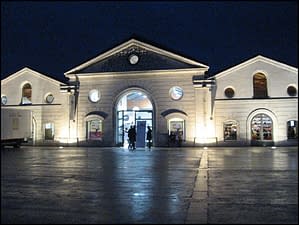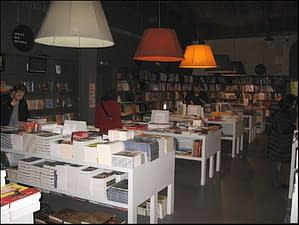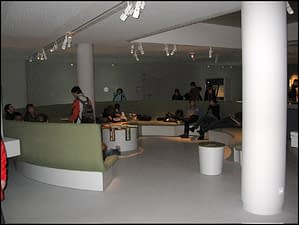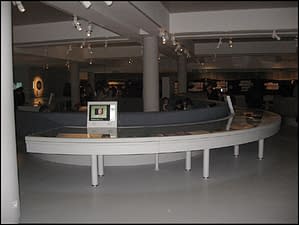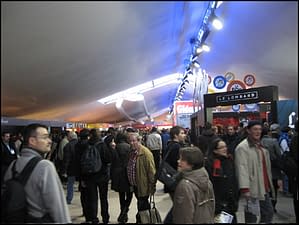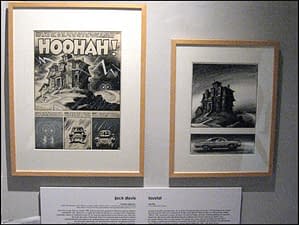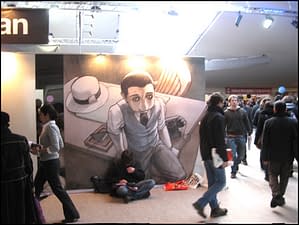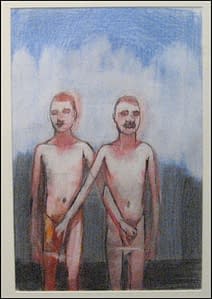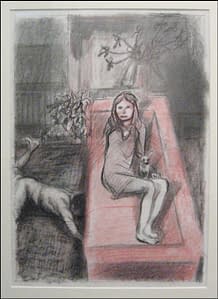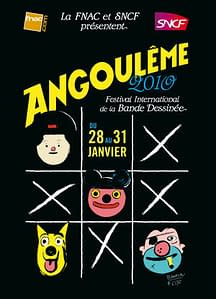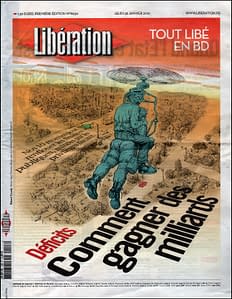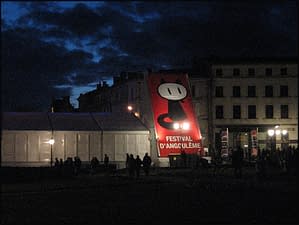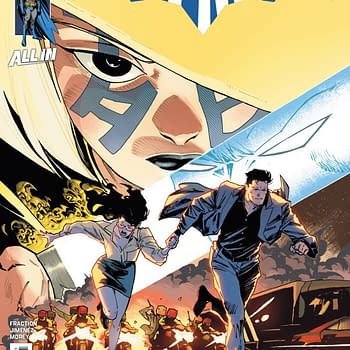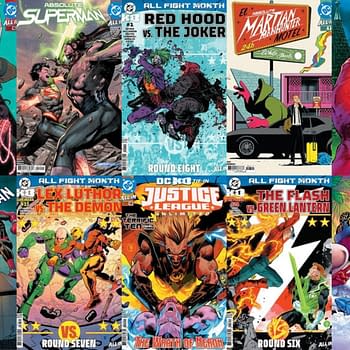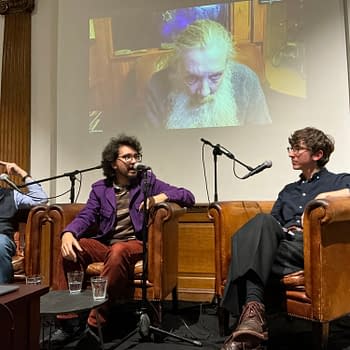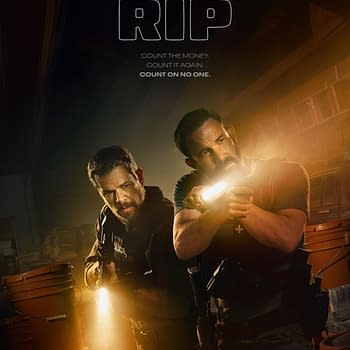Posted in: Recent Updates | Tagged:
Brave New Angoulême by Jim Wheelock
Coming back from an eleventh hour threat of the loss of major financing, this year's edition of the Festival International de la Bande Dessinée promised a lot — from the city's new comics museum to the return of Angoulême's favorite American son, Robert Crumb. As always, the F.I.B.D. delivered in ways I didn't expect.
Most of you reading Bleeding Cool have at least a vague idea what the Festival International de la Bande Dessinée is. It's the largest comics-related event in the western world, getting some 200,000 visitors in an average year, dwarfed only by the monstrous Comiket shows in Japan. This was the 37th year for the event, which runs the last weekend of January every year in the city of Angoulême in southwest France, and, as it happens, it was my own 20th consecutive year at the show, which I've written about in numerous venues over the years. Some battle-hardened comics pros say the thing is just another comic book convention, like San Diego or some Wizard monstrosity, but I don't believe that. I'll let you consider the evidence:
It starts as you're making your way across France to the F.I.B.D. and you realize is just how damn big an event the thing is. There are huge posters throughout the rail system – no surprise, since the S.N.C.F. is one of the major sponsors, and you see that newspapers and major magazines like Le Figaro and L'Express – the equivalent of the New York Times and Newsweek — have cover stories on the show. The weekly paper, Libération, in fact, always does a special issue in which the articles are completely illustrated by cartoonists. This year's number has a gorgeous Robert Crumb cover showing the terrified artist riding piggyback on a big Crumb gal who's flying a personal helicopter pack high over the countryside. This purports to illustrate a headline that translates as "Deficits – How to Win Millions". When you add to this the extensive radio and TV coverage the Festival gets, and you begin to understand just how important comics (a.k.a. "bande dessinée" or "BD") are to mainstream French culture.
The BD this festival is about range from sophisticated experimental art comics to humor, classic action adventure, fantasy and historical series, as well and manga and manhwa and children's comics. Most of them are published as "albums" – books, as opposed to American style monthly pamphlets. Some of them do contain superheroes, mostly reprints of the best American material, but the genre doesn't dominate the field the way it does in America.
The Festival is first and foremost about French language comics, but over the years the focus has become more and more international. Stalls in the various "bulles" – giant inflatable tents — sell comics in a dozen languages, and titles in the Fest's Sélection Officielle (from which the winners of the Fauve d'Angoulême prizes are selected) included French translations like Daniel Clowes'Eightball, Crumb's La Génèse and Hannah Berry's Britten et Associé, and manga like Motorô Mase's Ikigami: Prévais de Mort, to name just a few.
Angoulême has an International Rights area where professionals make publication deals for countries all around the world, and the exhibitions always feature at least one foreign country, but the real international action is in the local bars, which are jammed to the gills with artists, journalists, historians and exhibitors from throughout Europe, most of whom speak English as a second language.
Most of these international comics travelers tend to gravitate to Le Chat Noir, a pub in the old section of the city, where most of the restaurants are. On a given night during the Fest, you'll meet Finns, Germans, Brits, Swedes, Belgians, Swiss, the odd American, and possibly even a French person or two. The other major late night venue is the bar at the nearby Mercure Hotel. The Mercure is home to the Festival's major guests, with the remaining rooms bought out by the big publishers and stuffed with the nation's top BD auteurs.
Americans have been joining the party for decades, and I was surprised to find myself one of the few Yanks on hand this year who wasn't an exhibitor or an invited guest. A lot of British regulars I expected to see were absent, as well, possibly due to the sad state of the pound against the euro. Blame it on the economy all around, I'd guess.
To bad for them, because this year in Angoulême, there were numerous great art exhibits that would be front page news on their own if they were in Seattle or New York City, not to mention the spectacle of the new Musée de la Bande Dessinée.
For most visitors, this festival was their first introduction to the place, which opened in June of last year. The original Center National de la Bande Dessinée et le Image was the government's most expensive construction project outside of Paris some twenty years ago, a striking modern structure cut into a section of buildings bombed out in WWII. This second one, called more simply the Musée de la Bande Dessinée is far less imposing, at least from the outside. Sitting on a concrete covered island in the Charente river, the repurposed storage facility looks like little more than a suburban shopping mall.
The difference is on the inside, which houses what could well be the finest comics museum in the world, a fitting centerpiece to what is now christened the Cité International dc la Bande Dessinée et de la Image, a "city of comics" that now encompasses the old museum and several other venues.
The Musée is reached via a series of linked bridges that lead from the Rue de Bordeaux. Part way there, a statue of Hugo Pratt's hero "Corto Maltese" looks nobly out over the Charente river, which years ago powered the city's now vanished paper industry. This island area, I should mention, has been the subject of numerous BD-related construction schemes over the years by various local pols and interest groups – some of the fairly hare-brained. My personal favorite was a Tintin theme park centered around a gigantic version of the red-checkered rocket the iconic boy reporter took to the moon in Objectif Lune and On a Marché sur la Lune.
The Festival and the old C.N.B.D.I. made their name with brilliant, expensive exhibits featuring elaborate sculptured dioramas of characters and scenes that were the envy of the comics world. Probably the culmination of that was the Crumb exhibit in 1992 that featured sculptured recreations of his Zap covers, or the massive Mobius/Jean Giraud show a few years later. It's unlikely we'll see their kind again in the new museum – the wild 1990s money just isn't around anymore. What is there is amazing enough, though.
The museums major exhibit was the overwhelming, if not always brilliant, Cent pour Cent, devised out of the place's massive permanent collection of original comics art. The curators invited modern comics artists from all over the world to draw pages that responded to classic pages by the masters of the medium. Just as you entered, for example, you saw a stunning 1950s EC comics page by Jack Davis featuring a haunted house, paired with a reinvention of the page by the modern artist Loustal, putting the house in his own milieu. As the title indicates, there were a hundred of these pairings, and the results were mixed, ranging from straight reworkings to commentary and analysis on the subject page. Mattoti, for example, did a lovely color restyling of an Albert Breccia page, while Scott McCloud did a breakdown of a Fritzi Ritz strip by Ernie Bushmiller. There was, in fact, too much of a good thing for a single viewing. I will say that some pairings tended to diminish the modern artists who in their own work were equals of the classic artist, just because the were working on the other guy's home turf.
Moving further inside the Musée, you enter a spiral world of display cases backed by couches which feature more traditional displays of original art and related items. Here also are interactive videos of BD auteurs discussing their work, ranging from Hugo Pratt to "Sparky" Schulz. The spirals lead into other rooms with art on the walls, and huge couches. The emphasis is on comfort and on actually reading the stuff. Futuristic tables hold copies of BD for visitors' perusal. It's all pretty amazing, really.
At the end of my tour, I made a quick stop in the Musée's huge BD bookstore, already considered to be one of the best ones in Europe. Since the individual publishers in the big tents on the Champ du Mars sell only their own albums in their stalls, the bookstore is one of the few places where it's easy to find all your wants in a single place. Well worth a visit.
By my count, there were at least 18 art exhibits scattered around the town. I only got to some of them, and I'll only mention a few
Every year at the end of the Festival, the Grand Prix de la Ville D'Angoulême is awarded to a BD auteur who the becomes the President of the next year's show, the one who largely sets the tone for the event. The 2009 jury made a great choice in giving us Blutch.
Blutch, born in 1967, is a cartoonist who's enjoyed parallel careers in BD, working for the mainstream humor magazine Fluide Glacial while at the same time publishing more experiment art comics with l'Association and Editions Cornélius. As far as I know, he's never been published in English. I first discovered him with his 1999 album Blotch, which collected his stories about his alter ego, a cynical cartoonist living in a past that never happened, which puts the Fluide Glacial artists in a "sophisticated" 1930s New Yorker magazine universe. His many other works include Mitchum, Le Petit Christian and Sunnymoon.
In organizing his Presidential exhibit, Blutch stated said that he wanted his show to be entirely about drawing, rather than the comics medium. Situated in a too small space in the Place Henry Durant which appeared to be someone's empty apartment, the show emphasized his personal artwork, mostly pencil and watercolor drawings, dark, often erotic images featuring nudes and eerie wolf/dog animals. These drawings maintain a sketchy, unfinished feel. He often worked over semi-erased bits of drawing that he may have felt didn't work, leaving traces of them as haunting ghost images behind the finished art. His 1996 album, La Volupté, used this technique to great effect. The show, rounded out with some of his panel cartoons and grudging few comics pages, was to me the best one in Angou this year.
There's another kind of exhibition that you find in Angoulême, where the point isn't so much to show earth-shaking art as it is to provide access to a different world of comics culture. Nés en URSS is a prime example, featuring the work of young Russian cartoonists from Boomfest in St. Petersburg. Russia has no comics industry and little history with the medium. The short stories shown were good, if somewhat naïve, but part of the fun was watching artists raised without a larger comics culture reinvent the wheel.
Another fascinating approach to a different world was the publisher Frémok's exhibit, Match de Catch a Vielsalm, which chronicled the collaboration between cartoonists and mentally challenged artists in a Belgian Hospital.
Among the other shows were exhibits devoted to the autobiographical artist Fabrice Neaud, the comically surreal Fabui Viscogliosi , the U.S. Civil War set Belgian series "Les Tuniques Bleues, and the hit Manga, One Piece.
Over the last decade, the Festival's content had emphasized live discussions and theatrical events far more than in the past, including the highly successful Recontres Internationales which feature interviews with global creators. These events make use of simultaneous translation to allow everyone to understand what's going on. The guest list this year was phenomenal, a cross-section of the art comics world that included famed New Yorker artist Jean-Jacques Sempé, Joe Sacco, Ivan Brunetti, Dash Shaw, David Heatley, Kevin O'Neill and the prodigal, Robert Crumb.
For me, the Crumb appearance was anticlimactic — I didn't get in. The doors were shut on a fan-stuffed theater. I was at his appearance at U.C.L.A. a few months ago, so I admit I didn't try all that hard. Crumb is as big or bigger in France than he is in America, and from all accounts his hour talk on La Génèse was well received. True to form, he did his time and was out the door and on the road home in record time, his reluctance to participate being one of the classic tropes of the Festival for time immemorial.
One of the major phenomena of recent Angoulêmes are the Concerts de Dessins, or "Cartoon Concerts". These live performance events, in which artists draw in conjunction with live musical performers, have been sellouts every year since they began. The drawings are projected via an elaborate video hookup. This year's versions included Zep, the creator of the great children's character, Titeuf, and a Blutch performance illustrating the songs of Irene and Francis Jacob.
I was hoping for this sort of value added thing when I went to see Enki Bilal's performance of Cinémonstre, a live remix of his three feature films, Bunker Palace Hotel, Tykho Moon and Immortel accompanied by composer/performer Goran Vejvoda. Bilal is one of the great BD artists of the 60s and 70s, so I –and I think most of the audience – was hoping there'd be some drawing involved. Instead, we saw a sad attempt to create a workable narrative out of the films – each truly horrible in their own right – that was one of the most excruciating experiences I've ever had in a theater.
The politics of a running this big Festival, which relies on corporate sponsors and funding from local and national government is always fascinating, particularly in this era of financial crisis. Just nine weeks before the start of the Festival, the mayor of Angoulême, Philippe Lavaud, told the Festival organizers that the city would not be able to provide some of the services and funding that had historically been its part of the bargain. The amount talked about was between 100,000 and 300,000 euros, depending who you asked, loot that went to provide security and maintain the big inflatable tents that house much of the show. This prompted cries from the organizers that the show would not go on. They tried to get the publishers to put more money in, but they refused. Finally, the national government put up money and helped broker a compromise.
Naturally, when the Festival did happen, the local pols were around to take what credit they could, with local elections coming up, and to reassure the populace that the event was in no danger of having to leave town in the future. Lavaud himself was out there reinventing himself, and the Minister of Culture, Frédéric Mitterand, whose last minute intervention rescued the cash-strapped event, arrived to tell one and all the future of the Festival was secure "unless a bomb explodes". Even the hugely popular retired former Culture Minister, Jack Lang, made a return to Angoulême. It was Lang's support that allowed the expansion of the Festival in the 1980s and he had a key role in the construction of the first comics museum.
Even as current Minister Mitterand was wandering around, his staff was meeting with the representatives from the city and the Festival to reach agreement on funding future shows. As of early February, an accord appears to have been reached, but the actual contacts have not been signed.
Sadly for Bleeding Coolers, there wasn't much other scandal to be had. Rich already covered the brouhahah with the secret jury adjusted voting that gave Michael Rabagliati's Paul à Québec, a book not yet published in France, the Prix du Public, which is pretty small pommes frites as far a evil goes. It's more just an example of the political at the Festival, a drive on someone's part to make things work the way they thought they should. It's a far cry from the good old days when Angou's mayor ran off to Argentina with all the city's money – coming back years later when the cash ran out.
A full look at the awards could bog us down for days, so lets look at just a couple. In a field of extraordinary works by several masters of the medium, the jury chose Riad Sattouf's science fiction satire Pascal Brutal Tome 3 – Plus Fort Que Les Plus Forts for the top prize, the Fauve D'Or – Prix du Meilleur Album 2010. More importantly, the Grand Prix de lad Ville d'Angoulême went to Baru, making him the President of the 2011 Festival. The award is well deserved. Baru is a consummate draftsman, probably best known for his boxing saga, Le Chemin D'Amerique which won the best album award in 1991, and his manga-charged noir "road movie", L'autoroute du Soleil, which won the best album award in 1996.
The sign over the tent housing the alternative publishers read "Le Nouveau Monde", "the New World", and with the opening of the new comics museum, I think that described this latest era in the Fest's history. This has me thinking about some of the lost worlds of Angoulême.
Over the years, the Festival has done a lot to propel Angoulême on its journey from 11th century hill town to 21st century shopping mall city. In the old days, small local merchants put BD in their shop windows to commemorate the Festival. You'd see comics leaning against vacuum cleaners pots and pans. The Champ du Mars, which has housed the publisher's big tents for most of the show's 37 years, was the local bus terminal when I first hit town. It was surrounded by strange sleazy, little bars containing scary old Frenchmen who looked like they had done very bad things to people in the Indochine back in the day, who seemed bemused by all the bande dessinée hubbub. Today, the publisher's tents sit on top of an massive underground shopping mall, and the little bars have become upscale drinkeries, including an "American style" venue called the "Latitude Pub", and many of the small mom and pop stores I remembered are well gone.
Walking through Angou, I found I had a strange sense of something being different, but I couldn't place it. It took a day or so for me to figure it out. One of the joys of Festivals pas was the huge explosion of BD pop culture plastered along the streets – stickers and posters slapped all over, with prints of magazine covers stapled around electric poles. There was rock and roll grittiness, a punk zine scene energy to it all that was suddenly gone. I discovered what happened when I found a sign warning that security cameras were in operation, and stick stuff to the walls would not be tolerated. Now, young auteurs with unofficial exhibits, or their own BDs to sell, have little choice but to discreetly hand out leaflets in the street.
In the end, I'd say it was a very good year in Angoulême, if a somewhat subdued one. There were numerous solid, even brilliant, comic art exhibits, strong performance events, bearable weather and big crowds. Yeah, there were no life-changing shows or standout awesome new books that knocked your socks off, or left you with a hangover and a tattoo you can't understand, but all in all, a very good Fest. It bodes well for the newest incarnation of Angoulême – neater, cleaner and maybe less rock and roll, but good nonetheless.
Article and Photos ©2010 Jim Wheelock. All Rights Reserved.


